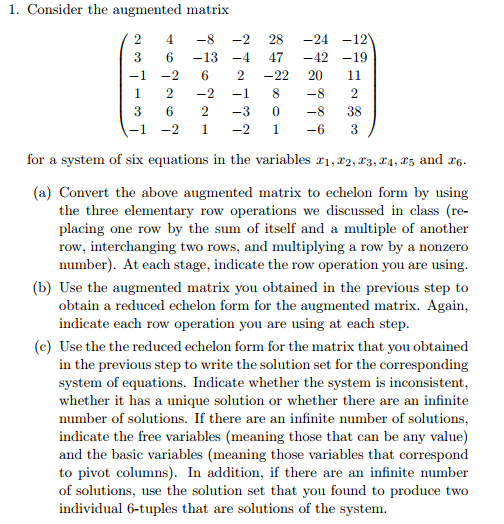MATH136 Lecture Notes - Lecture 10: Elementary Matrix, Augmented Matrix, Solution Set

Tuesday, May 23 − Lecture 10 : Gauss-Jordan elimination algorithm for solving
systems of linear equations.
Concepts:
1. Gauss-Jordan elimination algorithm for solving systems of linear equations.
2. consistent and inconsistent system.
3. ERO’s
We see that solving a system of linear equations which is in RREF is a relatively easy
task. However most systems we encounter are not in RREF. We now look at a technique
where we transform such systems in RREF without changing the solution.
10.1 Definition − Let [ A | b ] denote a system of linear equations. The Gauss-Jordan
elimination is an algorithm which transforms the system of linear equations [ A | b ] into
a system [ ARREF | d ] such that the resulting system [ ARREF | d ] has the same solution
set that of the original [ A | b ].
These changes are done by performing 3 "Elementary row operations" (ERO’s) on the
augmented matrix associated to the given system :
- ERO of type I : Interchange two rows of the system. We denote this row operation by
Pij, meaning we "permute" or exchange the i and j th rows.
- ERO of type II : Multiply a row of the system by a non-zero real number. We denote
this by cRi, meaning we multiply the row i with the scalar c.
- ERO of type III : Replace the ith row Ri with the sum of Ri and the scalar multiple of
row Rj. We denote this by Ri + cRj.
Note: We could actually apply the above operations to the system of equations and
referring to these as the 3 “equation-operations”:
- “ Pij” , interchange the order of two equations,
- “cEi”, multiply both sides of equation Ei by a non-zero scalar c,
- “Ei + cEj”, replace equation Ei, by the sum of the equation Ei and the equation
obtained by multiply both sides of the equation Ej by c.
Anyone of these 3 operations does not change the solution of the system.
The elementary row operations essentially describe the operations performed above in
solving the system of linear equations.
10.1.1 Note − Performing the elementary operations on a system always results in a
system which has the same solution as the system we started off with.
10.1.2 Remark − Any ERO can be "undone" by an ERO:
- To "undo" Pij apply Pij
- To "undo" cRi apply (1/c)Ri.
- To "undo" Ri + cRj apply Ri + (−c)Rj.
Verify this with a simple matrix.
10.1.3 Remark − For some there may be some confusion about the interpretation
given to an ERO such as, for example, 2R3 + R5.
- The ERO “2R3 + R5” is to be interpreted in the same ways as “R5 + 2R3”. It
means Replace row 5 with “2 times row 3 + row 5”
- Just to avoid confusion some may prefer to state the ERO as:
R5 → R5 + 2R3
which means the same thing.
- But do not write “R3 → 2R3 + R5”, which will surely confuse the reader.
10.2 General strategy for solving linear systems by using the Gauss-Jordan elimination.
System of linear equations
→ Obtain the augmented coefficient matrix [A|b]
→ Apply ERO’s to transform this matrix matrix [A|b] in RREF, [ARREF | d]
→ Transform back into the system of linear equations of [ARREF| d]
→ Isolate the basic variables.
→ Write the solution set in scalar form (expressing free variables as being equal to themselves.)
→ Write out the solution in “vector equation form”.
10.2.1 Note − If the operations are done accurately the solution to the system of linear
equation [ARREF | d] is identical to the solution of the system [A | b].
Also note that you can alter the order of the terms in your system of linear equations.
But once you have decided on an order of appearance, all of the variables in the
system of linear equations must appear in the same order before constructing the
associated augmented (coefficient) matrix. At that point each column in the
coefficient part of the matrix points to a specific variable.

34
MATH136 Full Course Notes
Verified Note
34 documents


